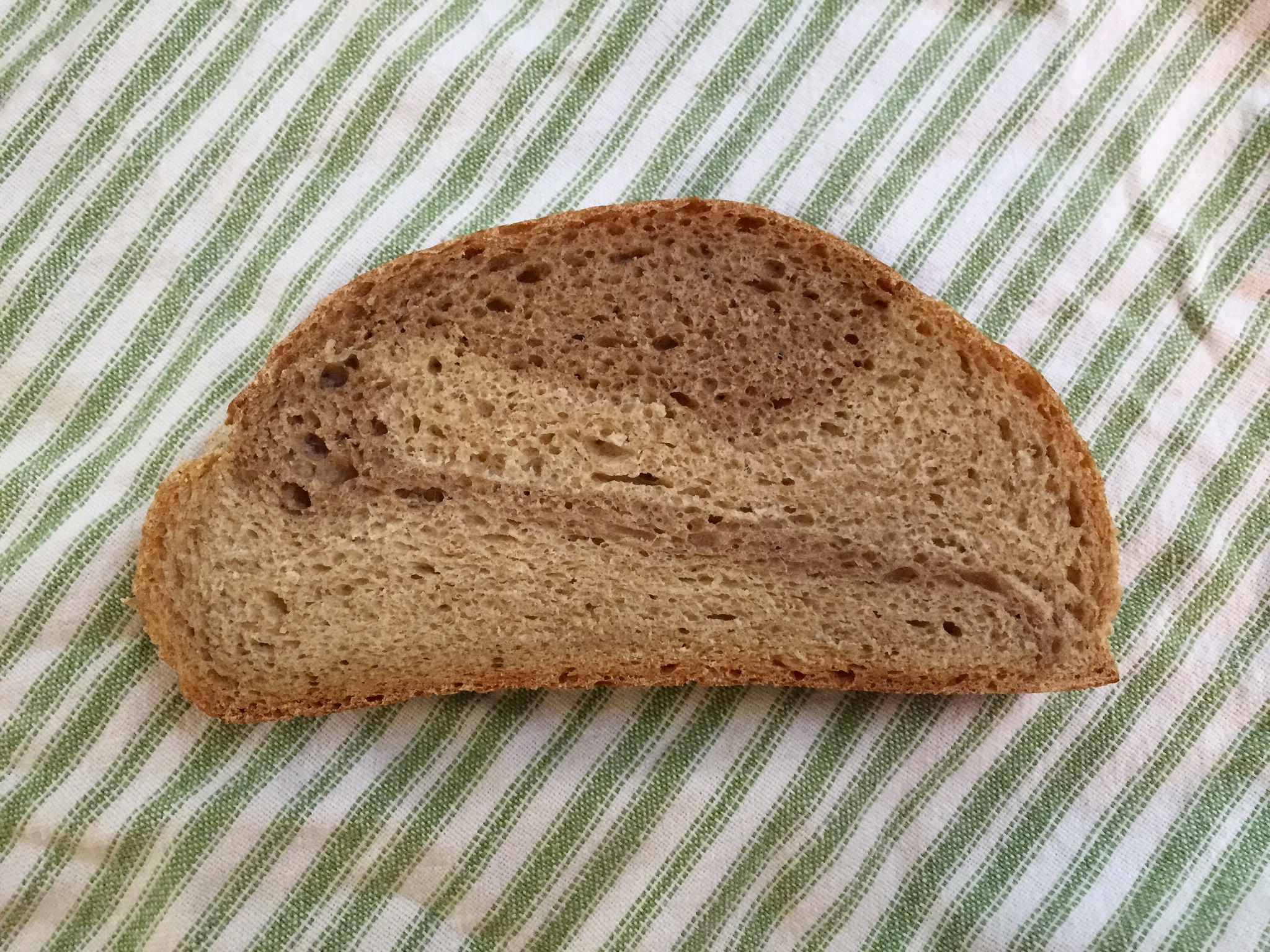Seinfeld fans will remember that the much-coveted loaf of marble rye was the source of much anxiety and borderline elder abuse in the episode “The Rye,” but you don’t have to go to New York to have some of your own– this recipe for marble rye from The Bread Baker’s Apprentice isn’t too hard to make and is delicious.
Don’t Overwork the Dough
Now that I’ve been working with rye flour for a few weeks, I’ve learned some interesting stuff about it as an alternative to plain ol’ wheat flour. Rye flour has some unique properties, most importantly that it doesn’t have as much gluten as wheat flour, so it needs to be treated a little differently when making bread dough. The intensive kneading we do with wheat flour dough is meant to maximize gluten development, but because rye flour has less gluten, it won’t develop those long gluten strands to the same extent. In fact, rye flour can become gummy if it’s overworked, so it’s important to not overknead the dough.
As a result of its less-efficient gluten development, rye dough tends to be less stretchy than wheat dough, and it does a poor job of forming air bubbles as bread rises. Rye bread will generally be denser, with smaller holes than a wheat bread. It also doesn’t benefit as much from long fermentation and long rises as much as wheat flour. This recipe has a combination of high-gluten wheat and rye flours, so this marble rye isn’t as dense as many 100% rye bread formulas, and you’ll have a little more flexibility when it comes to working with the dough.
Balancing Act
The only real challenge with this bread is that you’re using two different doughs — a dark rye, which has an extra ingredient for darker coloring, and light rye. If you end up with two doughs of different consistencies, they might not bake at the same rate– which would mean a loaf with some parts overcooked and some parts undercooked.
This isn’t the hardest task in the world, but it is important to check that the feel of each dough portion is (more or less) similar. You might have to add a little extra flour or water to one (or both) of the doughs to get them to the right consistency. As long as you’re aware of this as you’re preparing each portion, it’s nothing to stress out over.
Marble Rye Bread
From Peter Reinhart’s The Bread Baker’s Apprentice. Yields 1 large loaf.
Ingredients
Light Rye
- 3/4 c white rye flour*
- 1 1/2 c unbleached bread flour
- 3/4 tsp salt
- 1 tsp instant yeast**
- 1/2 tbsp molasses
- 1 tbsp butter, softened
- 5-6 ounces of water, room temperature
Dark Rye
- 3/4 c white rye flour*
- 1 1/2 c unbleached bread flour
- 3/4 tsp salt
- 1 tsp instant yeast**
- 1/2 tbsp molasses
- 1 tbsp butter, softened
- 5-6 ounces of water, room temperature
- 1 tbsp cocoa powder or coffee powder dissolved in 2 tbsp water
- or 1/2 tbsp liquid caramel coloring
Egg Wash
- 1 egg, whisked with 1 tsp water until frothy
Notes:
*Finding white rye flour can be surprisingly challenging. You can substitute dark rye flour with a portion replaced with regular bread flour to somewhat the same effect; for this recipe swap 1/4 cup of dark rye flour for wheat flour.
**If you’re worried, as many new bakers are, about your yeast not rising, be sure that you use yeast from the same batch/package for each dough segment. That way if it doesn’t rise well, they’ll flop equally. 🙂
To ensure that the rising time for each dough section is correct, I like to premix the dry ingredients for each section before I start mixing in the wet ingredients.
- Make the Light Rye Dough – Combine the dry ingredients for the “light rye” in a large mixing bowl, then add the molasses, shortening, and 5 ounces of water. Stir until the ingredients form a ball, adding the extra water as needed. Transfer to a floured counter and knead for 4-6 minutes by hand. The dough should feel supple and pliable, and shouldn’t be too sticky or too dry. Transfer to an oiled bowl and cover with plastic wrap.
- Make the Dark Rye Dough – As with light rye, combine the dry ingredients from the “dark rye” section, then add wet ingredients. Stir until a ball forms, adding water or flour to adjust the consistency. Aim to match the consistency of the light rye dough. Transfer to a floured counter and knead for 4-6 minutes by hand, then transfer to an oiled bowl.
- Ferment Doughs – Let both doughs rise for about 90 minutes, or until they are doubled in size.
- Shape the loaf – For a swirl effect, turn one of the doughs out onto a lightly floured counter and press into a rectangle, then repeat with the second, making the inside dough slightly smaller. Roll them into a spiral log. For a truly “marbled” loaf, cut each dough into 6 evenly-sized pieces and press them into a pile. Regardless of which method you choose, form the log of dough into a tight batard. Cover the loaf with an oiled piece of plastic wrap on a baking sheet and let rise for 60-90 minutes. Preheat the oven to 350°F.
- Bake the loaf – When the loaf is ready to go in the oven, gently brush the egg wash over the entire surface of the loaf, then place the loaf in the oven. Bake for about 45 minutes, turning once halfway through for even baking. The loaves should make a hollow sound when tapped from the bottom.
- Let cool for at least an hour before slicing and serving.



